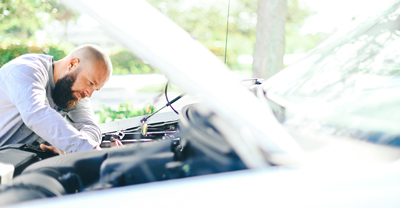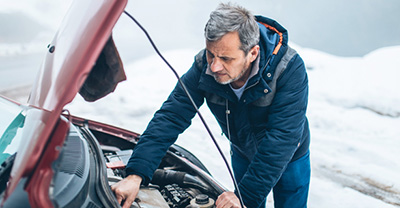Car maintenance basics: An illustrated guide


0 min. read
Basic car maintenance can cover a range of DIY and professionally managed tasks. But the goal is the same: to keep your vehicle running safely and help you avoid expensive, inconvenient, and stressful repairs. Explore Dairyland’s cheap car insurance options to find the coverage that fits your lifestyle and budget.
According to FinanceBuzz:
64% of drivers are currently putting off necessary car maintenance.*
56% of drivers say they paid for a car repair in the past year they believe would have been prevented if they’d maintained their vehicle.*
The top tasks that drivers put off include oil changes, tire replacements, and service related to “check engine” lights being on.
Creating a maintenance routine can take the guesswork out of caring for your vehicle and help catch small issues before they become costly headaches.
Regular inspection and maintenance
Change your oil

Neglecting to change the oil in your car can result in poor fuel efficiency at best and a seized engine at worst.
Check your owner’s manual for your vehicle’s suggested oil change interval—older cars require a pretty standard change every 3,000 miles, but most newer vehicles can go as long as 5,000-7,500 miles between changes.
Check your oil level monthly and before long trips. If it’s low, you can top off your oil, but if you’re frequently low on oil, take your car in for a more thorough inspection.
Monitor your tire pressure

Many new vehicles alert you if they sense a change in tire pressure, but it’s a good idea to manually check your tire pressure on a monthly basis and before long drives. Make sure all four tires are inflated to the same level and to the specifications for your vehicle, which is usually listed on a sticker inside the driver’s side door jam.
Hot weather causes the air in your tires to expand, and cold weather causes the air to contract, so you should expect changes in pressure with the seasons. You may have to remove air from your tires in the summer and add air in the winter to maintain optimal tire pressure.

Check and clean your battery

On average, a car battery lasts three years. Take note of when you last installed a new battery and check it more frequently as it ages. If you notice your lights are dimmer than normal or your car struggles to start, it’s time to change your battery.
Do a monthly visual check of the battery, noting and removing a buildup of dirt and dust on the terminals. If you see signs of corrosion, you can clean your battery connections, making sure to disconnect the cables in the correct order.
Wash your car

Get in the habit of washing your car. Take it through a car wash to remove corrosive road grime and help prevent rust—especially if you drive on treated winter roads. Cleaning the exterior of your car by hand also serves as a good opportunity to visually inspect your vehicle. Check for dents, scratches, and other damage you may not notice in your daily routine.
Clean glass, mirrors, and lights to help improve your visibility. Wiping down and vacuuming your interior can help prevent wear on the mats and seats. It’s also worth regularly cleaning out clutter and organizing car essentials to limit distractions on the road and prevent flying debris in the event of a quick stop or collision.
Pay attention to warning lights

It can be tempting to ignore warning lights when they appear—especially if you don’t know what they mean. But hoping they go away on their own can lead to dangerous and expensive consequences for you and your vehicle.
Dashboard warnings could indicate anything from low tire pressure to fluid leaks or an overheating engine. Some warnings are more immediate than others, but it’s always safest to respond to warning lights as soon as possible and address the malfunction.

Proactive part replacements
Replace your windshield wipers

If you’ve ever driven through a storm with bad windshield wipers, you’ll understand the importance of functional wiper blades. Luckily, replacing your windshield wipers is one of the most DIY-friendly car maintenance tasks. With the make and model of your vehicle, you can find out which wiper blades you need. And installation is often as easy as a couple of snaps, but instructions are provided with all wiper blades if you run into trouble.
As a rule, consider changing your wiper blades every six months. There are wiper blades specifically made for the winter and summer seasons, so fall and spring are a great time to change old for new and one style for the other.
If you notice any of the following, you'll want to replace your blades sooner rather than later:
A streaky windshield
Wipers making noise against the windshield
Blade rubber breaking down
Change your air filter

Changing your air filter improves the quality of air going to your engine. Cleaner air and a higher air flow can improve your gas mileage and prevent wear and tear on your engine.
You should change your filter every 12,000–15,000 miles, or more frequently if you drive in an area with high air pollution or in consistently dusty conditions. To change your filter, locate the filter housing—usually a plastic box adjacent to your battery—and lift the lid. Remove the old filter and clean any remaining debris from the housing before inserting the new filter and replacing the lid.
Follow a similar schedule for replacing your vehicle’s cabin air filter. You can usually find the housing in the back of your glove compartment.
Replace your headlights

Many people wait until one of their headlights goes out to change it. But driving with one headlight reduces your visibility and can make you less visible to other drivers. It’s also a ticketable offence in all US states. Instead of putting yourself at risk, watch for signs that your lights need to be replaced before they go out—like dim or flickering bulbs.
Depending on the make and model of your car, replacing your headlights could be a quick and easy DIY project, or something best left up to a professional. Open your hood and look behind your headlights for an access point. If you can easily reach down and access the light housing, you should be good to replace them yourself. Sometimes you can’t access the bulb housing without removing plastic panels, air intake ducting, or the bumper cover—that’s when to consult a mechanic.
To change the light bulb, remove the old one and plug in the new one according to manufacturer instructions. Then work in reverse to put anything you moved back in its right place.
Emergency maintenance
Flat tires

To help reduce your chances of getting a flat tire, regularly check your tire pressure and your tire treads, rotate your tires, and avoid road hazards. It’s also important to periodically check to make sure your spare tire is properly inflated and ready for use.
If you get a flat:
Don't brake suddenly.
Pull off to the side of the road and change the tire if it's safe.
If the tire can’t be repaired, replace it as soon as possible to limit the amount of miles you put on the spare tire.
Overheating engines

To help keep your engine from overheating:
Perform regular oil changes and maintain coolant and other fluid levels.
Avoid driving long distances when temperatures are very hot.
If your AC condenser is clogged or dirty, rinse it with water and, if necessary, a coil cleaning solution.
If your engine overheats:
Pull over, turn off the air conditioning, and turn on the heat (to pull heat from the engine).
Shut the engine off, then turn your key into the "ON" position to run the radiator fan.
Don’t open the hood immediately after you pull over—you could burn yourself. Wait at least 15 minutes to top off radiator fluid (if you have it on hand).
Call for assistance. If you need to drive to the nearest repair shop, wait until your temperature gauge drops back into the normal range.
Jump starting your vehicle

If you try to start your vehicle and it won’t turn over or you hear a clicking noise, your battery is dead and will need a jump start. It’s a good idea to keep a pair of jumper cables in your vehicle, especially if your battery is prone to dying.
You will need a car with a charged battery to assist you. Follow our step-by-step guide to jump start your car.
Seasonal car maintenance
Car maintenance is a year-round process, but it can be helpful to divide your maintenance tasks into the seasons when they’re typically most beneficial. Make it easy on yourself by consulting our seasonal car maintenance checklists linked below.
The general information in this blog is for informational or entertainment purposes only. View our blog disclaimer.
*Data accuracy is subject to this article's publication date.










